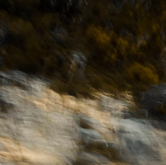Digital Escapes








Using my SLR camera I started documenting the landscape. Playing around in manual mode these images were not so much about the picture of the landscape but more about what it felt like while on the move through the landscape. Travelling though this vast empty space, one is consumed by beauty – a beauty that is difficult to capture by merely documenting it. In my desire to capture what I was seeing, and that I usually experienced through the means of painting, I had to change my approach and method using the only tool at my disposal - my camera. I started capturing what I saw - the motion in manual mode, which resulted in these extreme blurred images with a very definite textural element. I managed to capture marks that were very reminiscent of a painter’s hand - the mark making of brushwork in paint.
This reminded one of Turner’s landscapes. Not intentionally - it just happened, which made me happy as I have always been attracted to Turner’s paintings. Turner, commonly known as the “painter of light” could not be a more fitting artist for me in this project - in that the main source the camera uses to capture an image is light. Using light the camera is able to capture images with a sense of drama and atmosphere.
I further manipulated the images by editing them until they resulted in landscapes that captured, within the natural colours, layers of saturated and almost artificial colouring. Together with the dust specks due a dirty lens, we are reminded of the fact that we are not part of the landscape. We can experience it visually - but we are separated by the lens the camera or the windshield of the car.
The following quote is from an article that relates more to the hyper-reality of the virtual world. I question whether, in relation to my own work, there is a link between the fact that the digital image could be mistaken for an actual painting… that shift in thinking around what it is you are looking at.
Roe Etheridge refers to it as going into a fugue state – (loss of awareness of one’s identity…in this case the artwork)”
… internet creates a metaphorical world in which we conduct our lives. Through a “screen” the Internet, both as a technological artifact and as a popular image, provides a site for exploring “the world” and the position of such systems of totality in postmodernity. The seductive qualities of the Internet and technology can also lead to the creation of a “space” for drift, experimentation and play. The information superhighway depends upon a subtler metaphorical figuration, a virtual topography in which speed, motion, and direction become possible. Internet becomes a simulated territory we traverse via computer-modem roadster in which the computer screen replaces the windscreen. Baudrillard, following Roland Barthes, notes how easily motion can transform into a visual experience in which the driver-viewer interacts with images, rather than with the physical world.
(Mark Nunes: Jean Baudrillard in Cyberspace: internet, virtuality, and postmodernity)